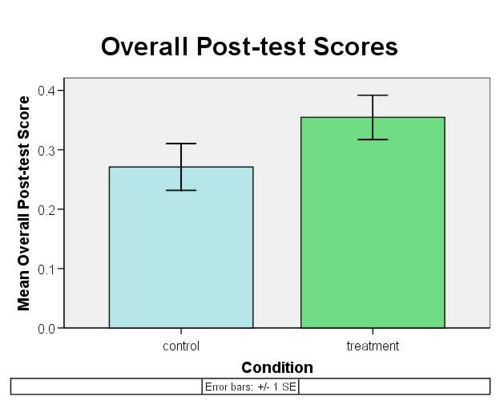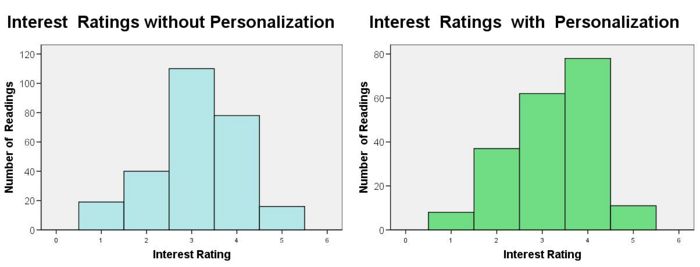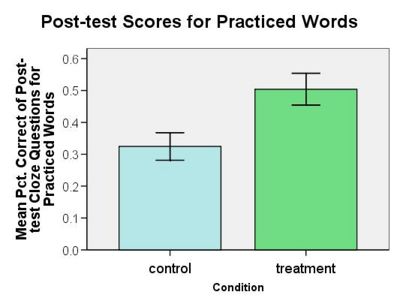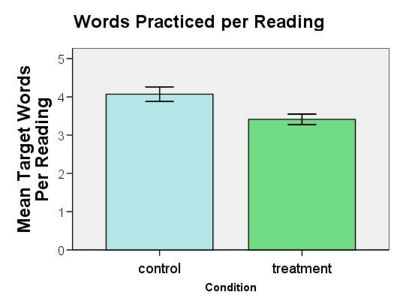REAP Multimodal Learning Fall 09
Contents
REAP Study on Multimodal Learning of Vocabulary
Logistical Information
| Contributors | Gabriel Parent, Luis Marujo, Adam Skory, Maxine Eskenazi |
| Study Start Date | September 11, 2006 |
| Study End Date | November 21, 2006 |
| Learnlab Courses | English Language Institute Reading 4 (ESL LearnLab) |
| Number of Students | 35 |
| Total Participant Hours (est.) | 270 |
| Data in Datashop | no |
Abstract
In this work, the term “personalization” refers to the selection of practice readings in order to match a student’s interests.
During each training session with the REAP Tutor, students work through a series of readings, each of which is followed by practice exercises for the target words in the reading. While reading a passage, students are able to access dictionary definitions for any word in a reading either by clicking on a highlighted target word or by typing a word into a box in the lower-left corner of the screen. The target words in the readings are also highlighted because highlighting may increase the use of dictionary definitions, thus encouraging students to coordinate multiple sources of information about a word’s meaning—namely, the implicit examples from context around words and the explicit generalizations in the definitions of words (as exemplified in the figure below)
A problem discovered in past studies with REAP is that many students spend only a brief amount of time on a reading and do not deeply process the text. Students often only read the dictionary definition for target words rather than attempting to process the entire context around the words. Inferring the meaning of vocabulary from context is a seemingly important strategy that is not used by such students. This behavior is likely due to a desire to perform well on post-reading practice exercises and post-test, which can be viewed as forms of extrinsic motivation. Intrinsically motivated students who are more interested in a reading are more likely to read the entire text and to use context to learn the meaning of unknown vocabulary. Therefore, personalization that increases intrinsic motivation could lead to deeper processing of context and better learning of vocabulary.
| Passive | Active | Interactive | |
| Explicit (general) | Dictionary Definitions | Practice Exercises | |
| Implicit (instance) | Interpreting meaning in context while reading | Sentence Production (assessment) | Practice Exercises |
Glossary
Intrinsic Motivation: Motivation to learn for learning's own sake rather than some external goal.
Extrinsic Motivation: Motivation for learn in order to satisfy an external goal, such as completing a task or passing an assessment.
Research question
Does personalization of practice readings to match students' personal interests increase ESL vocabulary learning?
Dependent variables
Normal post-test scores
Normal post-test scores for practiced words only
Long-term retention test scores, same post-test but administered months later.
Evidence of Transfer: sentence production tasks for target words, correct use of words in writing assignments for other courses.
Independent variables
Personalization of readings by topics of interest. In the control condition, the tutor did not use potential personal interest as a factor in its selection of reading materials. In the treatment condition, the tutor did use interest as a factor. All other selection criteria were the same in both conditions. Time on task was also the same.
Hypotheses
Since intrinsic motivation seems to be important in language learning, the benefits of personalization will outweigh the costs.
Findings
Personalization to match interests can lead to improved learning of the relevant knowledge components in a tutoring environment for vocabulary learning. Students in the treatment group correctly answered a higher proportion of questions on target words that were practiced in the REAP tutor.
Second, personalization can compromise domain-based goals. In the REAP tutor, an important domain-based goal is to give the student practice opportunities for many new target words. However, students receiving personalization practiced fewer target words. The difficulty in achieving the domain-based goal of practicing many unknown words is due to the fact that the REAP tutor often could not find texts that included multiple target words and also matched personal interests.
Third and finally, if the challenges of negotiating personalization and domain-based goals are met, personalization can lead to improvements in overall learning. Students with personalization appeared to learn the words they practiced with greater frequency but practiced fewer target words, and as a result did not perform reliably differently than their controls on the overall post-test measure for cloze questions. The researchers attributed this lack of a difference to the fact that, in many cases, the tutor had to choose between interesting readings and those with more practice opportunities. However, the availability of readings that are both interesting and provide ample practice is a technical issue which can be solved in a straightforward manner by increasing the size and coverage of the corpus of available practice reading passages.
Explanation
Students in the treatment condition with personalization performed slightly better on average (M=35.5%, SD=14.9%) in terms of overall post-test scores compared to students in the control condition (M=27.1%, SD=17.2%). However, this difference was not statistically significant.
There is evidence that the difference in post-test scores is due to increased interest leading to deeper processing of the reading practice texts.
Responses to questionnaires following each reading show the interest level of students using the REAP tutor. The questionnaires asked students to indicate on a scale from one to five their interest inr the preceding text. The distributions of post-reading interest ratings for students in the treatment and control conditions are shown below.
Students were also given an exit survey during their last week of practice with the tutor that asked them, among other questions, for to indicate whether they agreed with the statement, “Most of the readings were interesting.” The ratings were on a scale from one to five, with five indicating strong agreement and one indicating strong disagreement. Exit survey interest ratings by students in the treatment condition were significantly higher (p<0.05) than the ratings by students in the control condition. The mean response for students who received personalized readings was 3.18, while it was 2.65 for students in the control condition.
Further analysis of post-test scores reveals that students did learn more of the words that they actually practiced in REAP. The post-test contained 40 questions for target vocabulary words. Many of the students did not practice 40 words, so performance on practiced words alone was analyzed. Students in the treatment condition scored higher (N=16, M=50.3, SD=20.1) on questions for words seen in readings than did students in the control condition (N=19, M=32.4, SD=18.9). A two-tailed t-test for independent means verified that this result is statistically significant (t=2.719, df=33, p=0.005). The difference of scores between the two groups was 17.9% (95% CI = 4.5%, 31.3%), which corresponds to a large effect size of 0.85. This result indicates that personalization improved learning for the words that students saw in readings, which is in line with previous findings that intrinsic motivation leads to improved learning.
However, students in the treatment condition that included personalization saw fewer words in their training sessions (N=16, M=12.0 , SD=1.13) than students in the control condition (N=19, M=16.3, SD=0.87) (t=-2.9, df=33, p=0.006). Average time on task was essentially the same for students in both conditions. Students in the treatment condition spent slightly longer on each reading. The main reason, however, for the difference in the average total number of words practiced was that students for whom the tutor provided personalized instruction saw fewer words (M=3.41, SD=0.55) per practice reading passage than students in the control condition (M=4.07, SD=0.83) (t=2.929, df=33, p=0.006).
Thus, when the tutor used personalization as a factor in the selection of readings, it chose readings that were less valuable according to other factors. Specifically, this result shows that by personalizing instruction, the tutor was not able to provide practice for as many words. Of course, the practice that it did provide was better, as is shown in the previous result that for words student did practice, personalization appeared to increase learning.
The reduced number of target words per text with personalization is a technical issue which can be avoided in a straightforward manner by increasing the size of the database of readings. With more readings, the tutor can find texts that both have ample target words and cover topics of personal interest.
There is a possibility that the students in the treatment condition who were seeing fewer words in each reading were learning more of the words simply because they had fewer to learn per reading. To rule out this hypothesis, regression analyses (multiple linear regression) with overall post-test performance and performance for practiced words as the dependent variables. In both regression analyses, the number of target words per reading was not a significant predictor of performance. In fact, the number of target words per document was slightly positively correlated with post-test performance in both cases. This result seems to rule out the possibility that students were learning more target words in the treatment condition because they were seeing fewer words.
Long-term retention test results showed no reliable differences because of a small sample size. The test was administered to students who stayed in the ELI in the subsequent semester, which constituted only a fraction of the original sample.
Further Information
The following study addresses a different form of personalization, by which interactions with the learner (e.g., instructions, directions) are conducted using casual and direct rather than formal language:
Annotated bibliography
Note: a paper on this study has been submitted to International Journal of Artificial Intelligence in Education.
Clark, R. C. and Mayer, R. E. (2003). e-Learning and the Science of Instruction. Jossey-Bass/Pfeiffer.
Cordova, D. I. & Lepper, M. R. (1996). Intrinsic Motivation and the Process of Learning: Beneficial Effects of Contextualization, Personalization, and Choice. Journal of Educational Psychology. Vol. 88,l No. 4, 715-730.
Lepper, M. (1988). Motivational Considerations in the Study of Instruction. Cognition and Instruction. 5(4), 289-309.
Heilman, M., Juffs, A., & Eskenazi, M. (To Appear). Choosing Reading Passages for Vocabulary Learning by Topic to Increase Intrinsic Motivation. Proceedings of the 13th International Conferenced on Artificial Intelligence in Education. Marina del Rey, CA. (poster)




